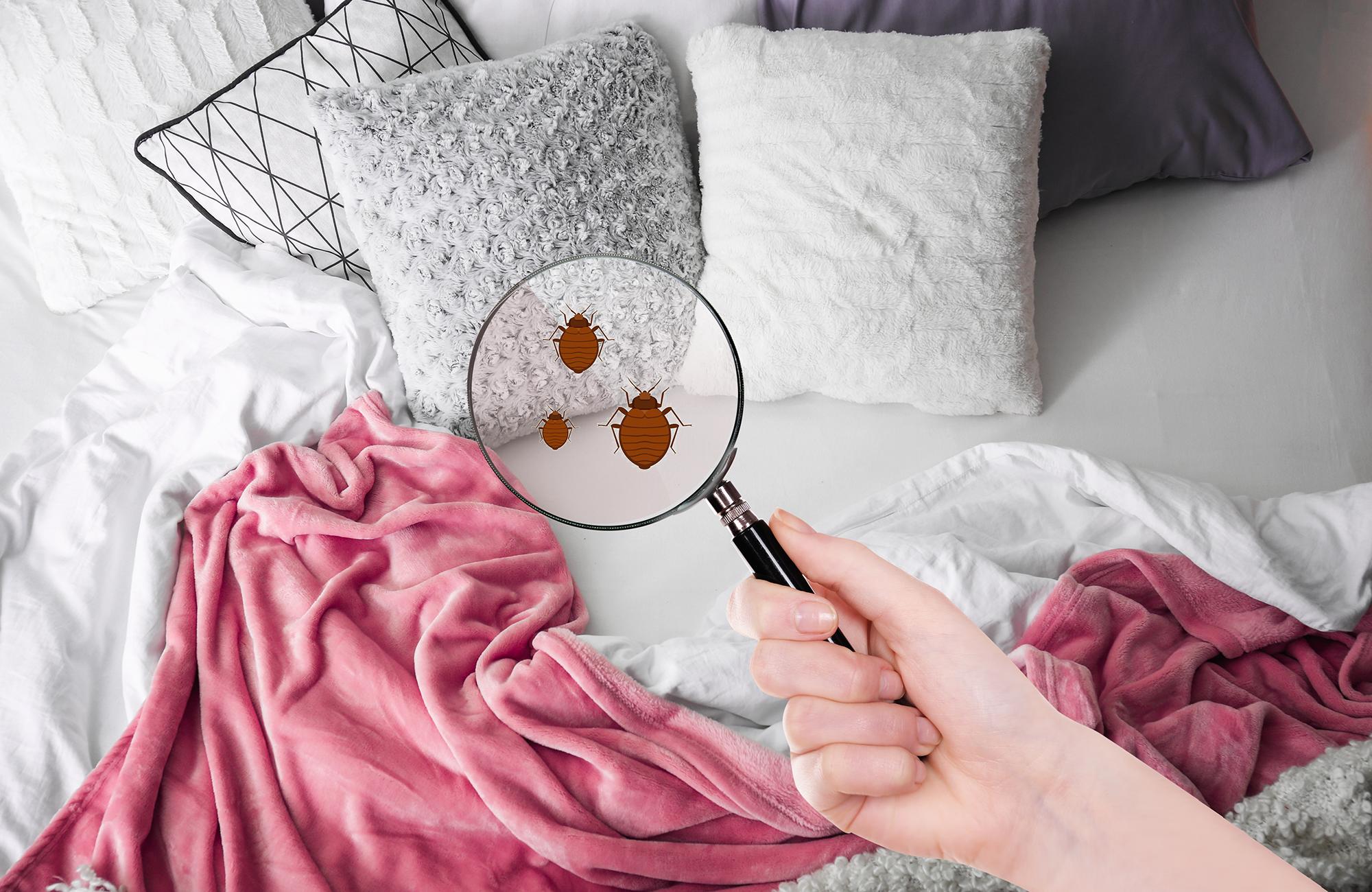Global travel has given bedbugs a free ticket to thrive.
Bedbugs are one souvenir you don’t want to bring home from a long-earned vacation, but they’re a fact of life. These little, reddish-brown, apple-seed-size bugs that cause itchy bites and welts on your skin love jumping onto stray pieces of luggage and clothes and hitching a ride back home. They are a byproduct of international travel.
Ever since the 1950s, when people started jetting around the world, they joined the travel wave, spreading their misery in all 50 states, as well as across the globe, according to the CDC. And with their growing resistance to insecticides, they have increased exponentially over the past decade. In France, for example, they are so problematic they now pose a national health hazard. Gross, right?
We caught up with Jody Gangloff-Kaufmann, an entomologist with the NYSIPM Program at Cornell University, to get the inside scoop on bedbugs, from how to avoid them to what to do if you think you have them.
Before You Travel, Get Familiar
Bedbugs have roamed the earth for more than 100 million years—they’re not going anywhere. The first line of defense is to know what you’re dealing with. They’re flat, little bugs measuring about 3/16 inches long, colored red to dark brown.
Recommended Fodor’s Video
“Bedbugs are wingless true bugs (Order Hemiptera) related to stink bugs and more distantly related to aphids and cicadas,” explains Gangloff-Kaufmann. “They have piercing-sucking mouthparts that they use to pierce the skin and draw up blood. Bedbugs feed on blood in every life stage except the egg. They have five juvenile stages and an adult stage, which means a single bedbug can give you a minimum of six bites if it lives long enough.”
And while their bites are not fun, and you really don’t want bedbugs, rest assured they don’t transmit disease organisms (though you’ll want to keep any bites clean to avoid infection).
Plan Ahead
Bedbugs do not discriminate, according to Gangloff-Kauffmann.
“World travelers [are] the people most likely to be exposed to bedbugs and transport them in their travels,” she says. “And while world travelers could be backpacking students staying in hostels, which often have bedbugs, even wealthy travelers pick up bedbugs.”
Research ahead of your travels to ensure your lodging does not have a bedbug infestation. Look at reviews on Yelp, Google reviews, TripAdvisor, and Hotels.com.
“People report bedbugs,” Gangloff-Kauffmann says. That said, remember that one or two rooms do not mean an entire hotel has an infestation. You can also check the Bedbug Registry, a free database of user-submitted bedbug reports across the U.S. and Canada.
Consider Your Suitcase
Even your suitcase can help ward off an attack. Bedbugs love the color black, the color of the preponderance of suitcases out there. Remember, it’s easier to spot dark-colored bugs against a lighter color. Also, a hard-sided suitcase is better than a fabric bag because it provides fewer access points for bedbugs.
The First Thing to Do When You Check Into a Hotel
Since hotels are the main place you may encounter bedbugs, there are solid ways to avoid becoming a bedbug victim. According to Gangloff-Kauffmann, bedbugs thrive in the dark, so the first thing you should do when arriving is turn off all the lights.
Examine the bed’s mattress seams, box spring, headboard, frame, and bedside table using an LED flashlight. Tiny, ink-colored dots or streaks could be traces of bedbugs. You should also check outlets, baseboards, pictures, and other tiny hiding places. If you find something—including anything skittering away for the cover of darkness—notify the hotel staff immediately. If you decide to stay at the hotel, be sure to ask for a room at least two floors away.
Use the Luggage Rack
Place your suitcase on the luggage rack or elsewhere in the hotel room, and not the bed—the safest places are on the counters or in the bathroom. Bedbugs are attracted to the scent on your clothes and will crawl into the suitcase and come home with you. For that matter, when you remove your clothes, put them safely away in your suitcase where the bugs can’t get to them.
Beyond Hotel Rooms
Unfortunately, hotels aren’t the only place where bedbugs can be found. “Bedbugs can be wherever people transfer them,” Gangloff-Kauffmann says. “We have seen bedbugs in airplanes, department stores, movie theaters, schools, basically wherever people go.” Essentially, bedbugs “infest” places—they become established and reproduce—where people sleep or sit quietly for long periods of time. That also includes cruise ships, buses, trains, even rental cars.
Proper precautions should be taken in all of these places. The best you can do is be aware. On the airplane, wear long clothing to minimize exposure since bedbugs can’t bite through clothes; and bring your own blanket and pillow. Also, it’s better not to check your luggage to avoid close exposure to other people’s luggage.
What to Do When You Get Home
The first thing you should do when you return from a trip is to keep your traveling items outside your home. You can put them in the garage or on the porch and leave your suitcase open—away from your bedroom.
Kill the Buggers
Even if you bring them home, you can kill accidental clingers and their eggs in the dryer. “Pop all clothing into a hot dryer to sanitize,” Gangloff-Kauffmann says. If your suitcase can go in the dryer, even better. And be sure to store your suitcase in the garage, outside the home.
What to Do if You Have Bed Bugs
If you think you have bedbugs, don’t freak out. You can start by using passive bedbug traps for early detection.
“Likely the first evidence of bedbugs will be bites—if you react to them; not everyone does—and fecal stains, which look like black magic marker stains,” Gangloff-Kauffmann says. Consider when you might have been exposed, what you had with you (luggage?), and inspect those items. And remember, if you abandon your bedroom because it has bedbugs, they will find you. These little buggies survive by feasting off your blood, and they seek you out through your C02 and body heat under the cover of darkness.
Call in the Professionals
If you do find them, don’t invest in expensive Home Depot remedies. The only sure way to eradicate them is to call a specialist. “It is very hard to do this on your own,” Gangloff-Kauffmann says.
Interestingly, many professionals use non-toxic methods of exterminating them. “Since many populations of bedbugs are resistant to common pesticides, many pest control professionals use heat, hot steam, diatomaceous earth dust, trapping, vacuuming, and a fungal biopesticide called Aprehend to control bedbugs,” Gangloff-Kauffmann says.
Digging Deeper
There are all kinds of resources out there to arm yourself in the bedbug fight. Orkin every year releases a report on the U.S.’s worst cities for bedbugs. Chicago took the cake in 2023 for the third year in a row, followed by New York and Philadelphia.
The Cornell University Library has an online guide, “How to Get Bed Bugs Out of Your Belongings,” that describes how to deal with various home items, like luggage. The Center for Disease Control has a bedbug FAQ sheet, as does the Environmental Protection Agency. And Bedbugs.net has lots of up-to-date info to learn more about these pests.




